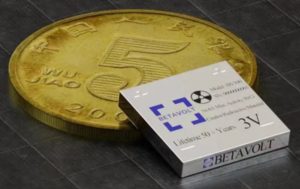BEIJING — Beijing Betavolt New Energy Technology Co. has announced what it calls a breakthrough in long-lived energy: a coin-sized “nuclear battery” — dubbed the BV100 — that the company claims can deliver steady power for 50 years without recharging or maintenance. But while the device’s core concept fits within known betavoltaic research, independent validation and scaling remain open questions.
“If policies allow, atomic energy batteries can allow a mobile phone to never be charged, and drones that can only fly for 15 minutes can fly continuously,” Betavolt said in Chinese trade press trading on its vision.
What Betavolt Claims
According to Betavolt and industry press:
- The BV100 module, measuring roughly 15 × 15 × 5 mm, is said to produce ~100 µW at 3 volts using a nickel-63 isotope layer sandwiched between diamond semiconductor converters.
- The company describes a novel single-crystal diamond converter only ~10 microns thick, with a 2-micron Ni-63 layer between two diamond diode layers.
- Betavolt claims that its battery has “absolutely safe, no external radiation” performance and can operate under extreme temperatures from –60 °C to 120 °C.
- The company says it intends to scale up via modular stacking (series/parallel) and hopes to launch a 1-watt version in 2025.
In statements to trade press, Betavolt asserts that the Ni-63 isotope decays into stable copper (Cu-63), eliminating long-term environmental risk.
What Independent Sources Corroborate
Industry and academic reporting suggest much of Betavolt’s core design is plausible and consistent with known paths in betavoltaic research:
- World Nuclear News describes Betavolt’s battery as in a pilot stage, citing the 50-year claim and the 100-µW/3-V output in the 15 × 15 × 5 mm module.
- In NEI Magazine, planners note that Betavolt is employing nickel-63 with diamond semiconductors in its design.
- IEEE Spectrum recently published a long-form piece on the broader resurgence of nuclear batteries, placing Betavolt among startups aiming to bring betavoltaics into sensors, drones, and medical implants.
Likewise, the technical literature supports that Ni-63 is a sensible choice for long-duration beta batteries (half-life ~100 years) and that betavoltaic cells typically trade power density for longevity.
Key Doubts and What Has Not Yet Been Proven
Despite the plausibility of the concept, several major claims are not yet independently confirmed:
| Claim | Why It Is Doubtful / Unproven | What Would Help Confirm |
|---|---|---|
| 50-year useful output | The isotope decay will reduce output over time. A 50-year life does not imply consistent power over decades. No public long-term performance data exist. | Long-duration testing under realistic load, with published decay curves |
| Scaling to watt-class output | Going from microwatts to watts without prohibitive size, cost, or safety burdens is extremely challenging. | Prototype watt-scale modules, published performance, comparisons vs. Li-ion or other power systems |
| “No external radiation / inherently safe” | Any nuclear device needs thorough shielding and certification. The company’s safety claims appear self-asserted and lack peer-reviewed validation. | Third-party radiation/leakage tests, regulatory approval in medical or safety domains |
| Mass production / manufacturability | Precision diamond- and thin-film semiconductor work, integration with radioactive materials, yield, and cost are major engineering challenges. | Data on yield, cost per unit, manufacturing scalability, reliability tests |
| Medical or consumer deployment | Implants, consumer electronics, drones carry strict safety, regulatory, biocompatibility, and reliability demands. | FDA/CE-type endorsements, long-term reliability studies in biological environments |
Media outlets occasionally overshoot in describing the battery’s potential. Some headlines call it a “100-year battery,” though Betavolt itself tends to anchor its more modest figure at 50 years.
Observers Urge Caution
One expert quoted in IEEE Spectrum notes that the renewals in betavoltaic research are promising, but warns that “what very few companies have been able to do is find a new market for these batteries and make a product that has impact.”
Betavoltaic power sources are not new: they have long been studied for niche roles such as pacemakers, remote sensors, and space probes. But past efforts faltered due to cost, safety, and limited output.
Likewise, in Chemistry World, analysts caution that many of Betavolt’s claims (e.g. large-scale production, smartphone-level power) remain aspirational.
Conclusion: A Real Prototype, but Hype Ahead
Betavolt’s claims are sufficiently grounded in established betavoltaic science to merit attention. The BV100 prototype fits broadly within expectations for Ni-63 + diamond diode devices: small, ultra-low power, long-lived. But the leap from a lab-scale demonstrator to mass-produced, watt-scale, consumer-ready, and medically safe devices is substantial and unproven.
Until independent third-party testing, published performance data, safety certifications, and manufacturing metrics emerge, Betavolt’s boldest projections should be treated as speculative. For now, the technology’s truest promise may lie in ultra-low-power domains (sensors, remote beacons, space probes) rather than everyday gadgets. (zai)
Sources: World Nuclear News, Chemistry World, IEEE Spectrum, South China Morning Post, Science Direct, NEI Magazine,

